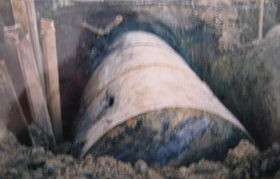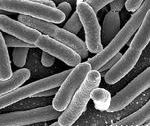Soil contamination
From Wikipedia, the free encyclopedia
Soil contamination is the presence of man-made chemicals or other alteration to the natural soil environment. This type of contamination typically arises from rupture of underground storage tanks, application of pesticides and herbicides, percolation of contaminated surface water to subsurface strata, leaching of wastes from landfills or direct discharge of industrial wastes to the soil. The most common chemicals involved are petroleum hydrocarbons, solvents, pesticides, herbicides, lead and other heavy metals. The occurrence of this phenomenon is correlated with the degree of industrialization and intensity of chemical usage.
The United States, while having some of the most widespread soil contamination, has actually been a leader in defining and implementing standards for cleanup. Other industrialized countries have a large number of contaminated sites, but lag behind the U.S. in executing remediation. Developing countries may be leading today in the next generation of new soil contamination cases.
The concern over soil contamination stems primarily from health risks, both of direct contact and from secondary contamination of water supplies[1]. Mapping of contaminated soil sites and the resulting cleanup are time-consuming and expensive tasks, requiring extensive efforts in the areas of geology, hydrology, chemistry and computer modeling.
Each year in the U.S., thousands of sites complete soil contamination cleanup, many by using microbes that “eat up” toxic chemicals in soil[2], many others by simple excavation and others by more expensive high-tech soil vapor extraction or stripper tower technology. At the same time, efforts proceed worldwide in creating and identifying new sites of soil contamination, particularly in industrial countries other than the U.S., and in developing countries which lack the money and the technology to adequately protect soil resources.
Contents |
Microanalysis of soil contamination
To understand the fundamental nature of soil contamination, it is necessary to envision the variety of mechanisms for pollutants to become entrained in soil. Soil particles are complex particles that may be composed of a gamut of organic and inorganic chemicals. For example, at the extremes, one has sand, a coarse grained totally inorganic substance; whereas peat is a fine organic material, made of decomposing organic material. Most soils are mixtures of soil subtypes and thus have quite complex characteristics. There is also a great diversity of soil porosity, ranging from gravels to sands to silt to clay (in decreasing order of porosity). Finally there is a wide spectrum of chemical bonding or adhesion characteristics: each contaminant has a different interaction or bonding mechanism with a given soil type.
On balance, some contaminants may literally drain through soils such as sand and gravel and move to other soils or deeper aquifers, while polar or organic chemicals discharged into a clay soil will have a very high adsorption. Thus most soil contamination is the result of pollutants adhering to the soil particle surface, or lodging in interstices of a soil matrix. Clearly the equilibrium reached is a dynamic one, where new pollutants may lodge on new soil particles and the action of groundwater movement may over time transport some of the soil contaminants to other locations or depths.
Principal sources of soil contamination
There are legions of contaminant sources and pollutant types, but the following list is illustrative (pollutants indicated by parentheses):
- Petroleum hydrocarbons from rupture of underground storage tanks (benzene, toluene, xylene, alkanes, alkenes, MTBE)
- Spillage or leakage of solvents and dry cleaning agents (acetone, trichlorethylene, formaldehyde) and perchloroethylene
- Leaching of contaminants from solid waste disposal sites (lead, mercury, chromium, cadmium, bacteria, hydrocarbons)
- Percolation into soils from pesticides and herbicides uses (wide variety of chemicals including DDT, lindane, organochlorines, organophosphates, carbamates, cyclodienes)[3]
- Lead deposition from lead abatement or construction demolition (lead)
- Leakage of transformers (PCB)
Health effects
The major concern is that there are many sensitive land uses where people are in direct contact with soils such as residences, parks, schools and playgrounds. Other contact mechanisms include contamination of drinking water or inhalation of soil contaminants which have vaporized. There is a very large set of health consequences from exposure to soil contamination depending on pollutant type, pathway of attack and vulnerability of the exposed population. Chromium and many of the pesticide and herbicide formulations are carcinogenic to all populations. Lead is especially hazardous to young children, in which group there is a high risk of developmental damage to the brain and nervous system, while to all populations kidney damage is a risk.
Chronic exposure to benzene at sufficient concentrations is known to be associated with higher incidence of leukemia. Mercury and cyclodienes are known to induce higher incidences of kidney damage, some irreversible. PCBs and cyclodienes are linked to liver toxicity. Organophosphates and carbamates can induce a chain of responses leading to neuromuscular blockage. Many chlorinated solvents induce liver changes, kidney changes and depression of the central nervous system. There is an entire spectrum of further health effects such as headache, nausea, fatigue, eye irritation and skin rash for the above cited and other chemicals. Clearly at sufficient dosages a large number of soil contaminants cause death.
Ecosystem effects
Not unexpectedly, soil contaminants can have significant deleterious consequences for ecosystems[4]. There are radical soil chemistry changes which can arise from the presence of many hazardous chemicals even at low concentration of the contaminant species. These changes can manifest in the alteration of metabolism of endemic microorganisms and arthropods resident in a given soil environment. The result can be virtual eradication of some of the primary food chain, which in turn have major consequences for predator or consumer species. Even if the chemical effect on lower life forms is small, the lower pyramid levels of the food chain may ingest alien chemicals, which normally become more concentrated for each consuming rung of the food chain. Many of these effects are now well known, such as the concentration of persistent DDT materials for avian consumers, leading to weakening of egg shells, increased chick mortality and potentially species extinction.
Regulatory framework
Until about 1970 there was little widespread awareness of the worldwide scope of soil contamination or its health risks. In fact, areas of concern such as Love Canal were often viewed as unusual or isolated incidents. In the U.S., passage of the National Environmental Policy Act in 1969 required careful analysis of the consequences of any federally funded project. Passage of The Resource Conservation and Recovery Act (RCRA) by the U.S. Congress in 1976 established guidelines not only for handling of hazardous materials but transport and hauling[5], such as required in cleanup of soil contaminants[6]. In 1980 the U.S. Comprehensive Emergency Response Compensation and Liability Act (CERCLA) was passed[7] to establish, for the first time, strict rules on legal liability for soil contamination. Not only did CERCLA stimulate identification and cleanup of thousands of sites, but it raised awareness of property buyers and sellers to make soil contamination a focal issue of land use and management practices.
While estimates of remaining soil cleanup in the U.S. may exceed 200,000 sites, in other industrialized countries there is a lag of identification and cleanup functions. Lesser developed countries are not without a share of the creation of soil contamination. Even though their use of chemicals is far less than industrialized countries, often their controls and regulatory framework is quite weak. For example, some persistent pesticides banned in the U.S. for decades are in widespread uncontrolled use in developing countries. It is worth noting that the cost of cleaning up a soil contaminated site can range from as little as about $10,000 for a small spill, which can be simply excavated, to millions of dollars for a widespread event, especially for a chemical that is very mobile such as MTBE or perchloroethylene.
Cleanup options
Cleanup or remediation is analyzed by environmental scientists who utilize field measurement of soil chemicals and also apply computer models for analyzing transport[8] and fate of soil chemicals. Thousands of soil contamination cases are currently in active cleanup across the U.S. as of 2006. There are several principal strategies for remediation:
- Excavate soil and remove it to a disposal site away from ready pathways for human contact
- Aeration of soils at the contaminated site (with attendant risk of creating air pollution)
- Microbial digestion of certain organic chemicals (by using commercially available microflora)
- Extraction of groundwater or soil vapor with an active electromechanical system, with subsequent stripping of the contaminants from the extract.
- Containment of the soil contaminants (such as by capping or paving over in place)
References
- ↑ ‘’Risk Assessment Guidance for Superfund, Human Health Evaluation Manual’‘, Office of Emergency and Remedial Response, U.S. Environmental Protection Agency, Washington D.C. 20450
- ↑ D.A. Crossley, ‘’Roles of Microflora and fauna in soil systems’‘, International Symposium on Pesticides in Soils, Feb. 25, 1970, University of Michigan
- ↑ E.P. Lichtenstein, Fate and Movement of Insecticides in and from soils International Symposium on Pesticides in Soils, Feb. 25, 1970, University of Michigan
- ↑ C. Michael Hogan, Leda Patmore and Harry Seidman ‘’Computer modeling of pesticide transport in soil for five instrumented watersheds’‘, prepared for the U.S. Environmental Protection Agency Southeast Water laboratory, Athens, Ga. by ESL Inc., Sunnyvale, California (1973)
- ↑ Jeff Belfiglio, Thomas Lippe and Steve Franklin, Hazardous Waste Disposal Sites, Stanford Environmental Law Society, Palo Alto, Ca. (1981)
- ↑ U.S. Resource Conservation and Recovery Act (RCRA), Public Law 94-580, 90 Statute 2796 (codified at 40 U.S.C., 6901-6987 (1976 and suppl III 1979)
- ↑ U.S. Comprehensive Emergency Response Compensation and Liability Act (CERCLA) Public Law, codified at 42 U.S.C. §§ 9601 to 9675, enacted by the United States Congress on December 11, 1980
- ↑ S.K. Gupta, C.T. Kincaid, P.R. Mayer, C.A. Newbill and C.R. Cole, ‘’A multidimensional finite element code for the analysis of coupled fluid, energy and solute transport’‘, Battelle Pacific Northwest Laboratory PNL-2939, EPA contract 68-03-3116 (1982)



